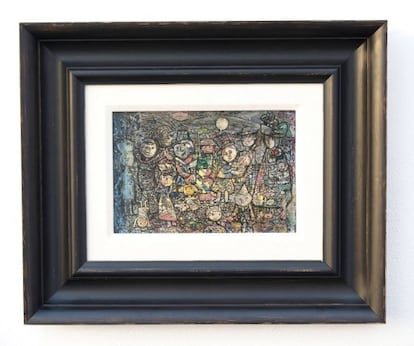Stolen Cuban art surfaces in Miami
Collector alerted Havana after discovering painting by Eduardo Abela at a Florida gallery National Museum officials believe some 100 works may have been robbed

Collector Ramón Cernuda was the first to alert the Cuban authorities about his suspicion that they might have an art thief on their hands – and as it turned out, his suspicion was right.
Two weeks ago, someone sold the Cuban collector a painting at an art gallery in Miami, a work that was taken from the National Museum of Fine Arts in Havana.
Luz Merino, the museum vice president who took the call, told Cernuda that no one had reported any robbery but in any case she would go to the storeroom to see if anything was missing. After a three-hour search, she confirmed that the painting Cernuda had purchased had indeed been taken from the museum. When and by whom, however, remain a mystery.
Still worse, Merino was able to confirm that around 100 works of art, valued at thousands of dollars, have also disappeared.
Carnaval Infantil by Cuban avant-garde painter Eduardo Abela, who reached his artistic peak in the early 1950s, was the first work that Cernuda found at a Miami gallery in the middle of February. The small 30x20 centimeter oil on wood painting sold for $15,000.
“We found out it had been stolen when we were cataloguing the work and saw a reproduction of it in a book about Abela, published in Seville, which clearly stated that the original belonged to the collection of the National Museum,” Cernuda told EL PAÍS. “We immediately phoned museum officials.”
We found out it had been stolen when we were cataloguing the work ”
Cernuda has been the owner of the Cernuda Art Gallery in Coral Gables, Florida, since 2000 and has cooperated in the past with the special FBI squad that deals with stolen art and antiques. Two years ago, he helped in an undercover sting operation that took place at his gallery when a group of art thieves tried to sell him about a dozen works by Cuban modernists René Portocarrero, Mariano Rodríguez, Antonio Gatorno and Amelia Peláez, which had all been stolen in Miami.
After informing Havana museum officials about his find, Cernuda returned to the gallery where he purchased Carnaval Infantil.
“The following day I investigated what else was there. That’s when they showed me 10 works by [Leopoldo] Romañach, which had been torn with a knife. The thieves had cut the paintings instead of taking the time to remove the nails from the frames.”
A follow-up call to Havana revealed that those works also belonged to the museum.
On February 28, Cuba’s National Council for Cultural Heritage officially confirmed that “an important breach had been detected” at the museum. “The entrance to the building had not been broken into so the exact date as to when the robbery took place cannot be determined,” it said in a statement. “Most of the works that have been stolen are from the Arte Cubano period, known for its transition from the academic to modern schools, and especially for the paintings of Leopoldo Romañach.”
Cernuda said that Cuban authorities have so far detected that around 95 works have disappeared from the museum and haven’t ruled out that more paintings and art objects are missing.
Founded in 1913, the National Museum of Fine Arts in Havana houses the most complete collection of Cuban artworks from between the 16th and 20th centuries. This isn’t the first time there has been a robbery at the museum but it is the first time that the Cuban government has acknowledged that art is missing.
Carnaval Infantil is now in the hands of the FBI and will eventually be returned to the Havana museum. “There is already a grand jury evaluating whether to file charges against certain people here in the United States,” Cernuda said.
Tu suscripción se está usando en otro dispositivo
¿Quieres añadir otro usuario a tu suscripción?
Si continúas leyendo en este dispositivo, no se podrá leer en el otro.
FlechaTu suscripción se está usando en otro dispositivo y solo puedes acceder a EL PAÍS desde un dispositivo a la vez.
Si quieres compartir tu cuenta, cambia tu suscripción a la modalidad Premium, así podrás añadir otro usuario. Cada uno accederá con su propia cuenta de email, lo que os permitirá personalizar vuestra experiencia en EL PAÍS.
¿Tienes una suscripción de empresa? Accede aquí para contratar más cuentas.
En el caso de no saber quién está usando tu cuenta, te recomendamos cambiar tu contraseña aquí.
Si decides continuar compartiendo tu cuenta, este mensaje se mostrará en tu dispositivo y en el de la otra persona que está usando tu cuenta de forma indefinida, afectando a tu experiencia de lectura. Puedes consultar aquí los términos y condiciones de la suscripción digital.
Últimas noticias
Most viewed
- Pablo Escobar’s hippos: A serious environmental problem, 40 years on
- Reinhard Genzel, Nobel laureate in physics: ‘One-minute videos will never give you the truth’
- Why we lost the habit of sleeping in two segments and how that changed our sense of time
- Charles Dubouloz, mountaineering star, retires at 36 with a farewell tour inspired by Walter Bonatti
- The Florida Keys tourist paradise is besieged by immigration agents: ‘We’ve never seen anything like this’









































